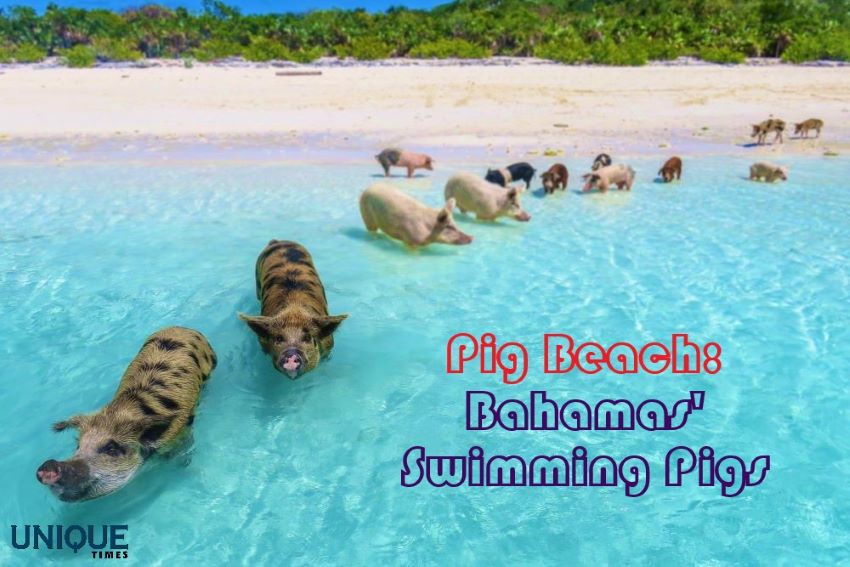Exploring Pig Beach: The Fascinating Tale of Bahamas’ Swimming Pigs

In the turquoise waters of the Bahamas lies a captivating paradise like no other – Pig Beach. Contrary to conventional belief that islands are inhabited solely by humans, this uninhabited gem is home to a peculiar and adorable community of swimming pigs. Set amidst the breathtaking natural beauty of the Caribbean, Pig Beach has gained worldwide fame and admiration, becoming a must-visit destination for travelers seeking unique experiences. In this blog, we embark on a journey to uncover the mysteries, history, and allure of this extraordinary island.
The Origins of Pig Beach
Pig Beach, also known as Big Major Cay, is one of the many cays in the Exuma archipelago of the Bahamas. Although the exact origins of the swimming pigs remain unclear, local legends suggest that a group of pigs was left on the island by sailors as a future food source. However, instead of meeting their demise, these intelligent and resourceful creatures adapted to their new surroundings and thrived.
The Swimmers of Pig Beach
As visitors approach the shores of Pig Beach, they are greeted by a heartwarming sight – the endearing sight of pigs paddling gracefully through the crystal-clear waters. These feral yet friendly pigs have become accustomed to human presence over the years and are known for their endearing behavior. As they swim alongside delighted tourists, these swimming pigs have earned the title of “Bahamas’ Swimming Pigs.”
Feeding Rituals and Conservation Efforts
While the pigs are excellent swimmers, they still require sustenance to maintain their health. Tourists and locals alike participate in feeding rituals, providing them with nutritious food. It’s essential to ensure that the food offered aligns with their dietary needs and doesn’t harm the island’s ecosystem.
In recent years, Pig Beach has seen a rise in eco-conscious tourism. Various conservation efforts are now in place to protect the pigs and their habitat. Local authorities and organizations collaborate to raise awareness about responsible tourism, keeping the island pristine for generations to come.
The Allure of Pig Beach: A Unique Tourist Destination
Pig Beach has garnered international attention, becoming a symbol of unanticipated wonders of nature. It has become a bucket-list destination for travelers seeking offbeat experiences and a chance to witness these extraordinary creatures in their element. The photos of playful pigs splashing in the turquoise waters have taken social media by storm, luring in wanderlust-stricken travelers from all corners of the globe.
Tips for Visiting Pig Beach Responsibly
- Respect their space: While the pigs may appear friendly, remember they are wild animals. Maintain a safe distance to avoid any potential harm to yourself or the pigs.
- Eco-friendly practices: Follow the principles of sustainable tourism. Avoid leaving behind any trash and use reef-safe sunscreen to protect the fragile marine ecosystem.
- Mindful feeding: If you wish to feed the pigs, ensure you provide them with appropriate food that won’t harm their health.
- Hire local tour operators: Choose reputable tour operators who prioritize the welfare of the pigs and the conservation of Pig Beach.
Conclusion
Pig Beach in the Bahamas stands as a testament to the extraordinary ways in which nature can surprise and enchant us. The swimming pigs of Pig Beach have found an unlikely paradise in this uninhabited island, capturing the hearts of all who visit. As we venture into this fascinating slice of paradise, let us remember the importance of responsible tourism and the need to protect such unique wonders for future generations to marvel at.
So, if you’re looking to embark on a truly unforgettable adventure, hop on a boat and set sail to the Bahamas’ Pig Beach, where the charms of these lovable swimming pigs will undoubtedly leave you with lasting memories and a deeper appreciation for the wonders of the natural world.
Picture Courtesy: Google/images are subject to copyright








